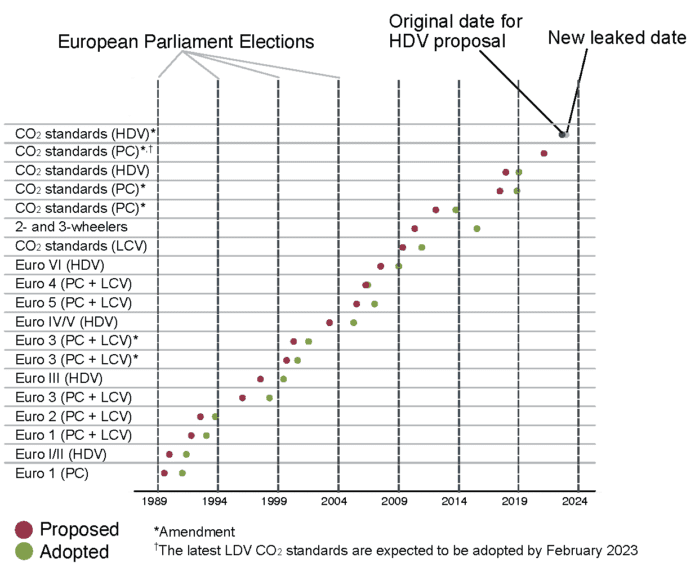Recommendations for revising the modalities of Europe’s heavy-duty vehicle CO2 standards
Blog
Europe’s heavy-duty CO2 standards risk being delayed. Our climate can’t wait.
U.S. politician and writer Eugene McCarthy had an arguably pessimistic outlook on the role of governance, once saying, “The only thing that saves us from the bureaucracy is inefficiency.” Whether you agree or not with McCarthy, one of the bureaucracy’s latest inefficiencies is far from saving us. This time, it comes in the form of a delay to a revision to Europe’s CO2 standards for trucks and buses, which was originally planned for last November and now risks being pushed back to May.
Despite constituting only a small fraction of the vehicle stock (about 2% of all vehicles on the road), trucks and buses emit over one quarter of road transport greenhouse gas emissions in Europe, and 6% of the Union’s total emissions. The current CO2 standards cover most trucks, but not buses, and require a 30% reduction in new vehicle emissions by 2030. Considering Europe’s aim to achieve climate neutrality by 2050, it’s clear trucks and buses are not on the right track to deliver a decarbonized future.
The European Commission pledged to revise the standards and get them back on track. This was meant to come in the form of a proposal delivered by November 2022. Contexte recently leaked the College’s tentative agenda for the coming months, which shows the release of this proposal pushed back to the end of May.
It might not seem it, but a delay of six months is a big deal. Once a regulation is proposed (or a revision in this case), it’s basically brought into a boxing ring, with the European Parliament on one side and the Council of the European Union on the other, where they battle it out to get their own amendments put in, while the European Commission stands by as the referee. There’s no limit on the number of rounds, but usually for most road transport related policies, the whole match lasts about a year.
The big issue here is that one year from the leaked proposed release date, May 2023, brings us dangerously close to the next European Parliament election cycle, planned for mid-2024, which could really complicate things; a boxing match can get very confusing if your opponent changes halfway through the match. Very rarely have similar policies been proposed so close to the Parliament election (see chart).

Timeline of the proposal and adoption of transport standards compared to the dates of European Parliament elections
History suggests that even with a delay an agreement might still be reached before next year’s election. However, this will still put significant pressure on Council and Parliament to come to an agreement in time, especially if the proposal includes any contentious issues, such as a phase out of fossil fueled trucks and buses. Preventing a delay in the proposal’s release will allow time for discussions to be based on sound reason and analysis, not on pressure-based concessions.
The reasoning behind the delay is seemingly to lump the CO2 standards proposal with an upcoming Greening Transport Package. This package will include various other elements, such as revisions to the weights and dimensions Directive, the establishment of a framework for the measurement of logistics emissions, and measures to increase the modal share of rail traffic.
The CO2 standards should take precedence above all of these. It brings the opportunity to fully decarbonize the freight sector if a phaseout of the internal combustion engine is proposed. Considering the weight carried by these standards, the negotiations should be allowed ample time to take place.
An early proposal also brings opportunity. From January through June of this year, Sweden holds the position as the presidency of the Council of the European Union, meaning they will set the agenda for Council over this timeframe. Sweden has the best climate track record of any Member State, with economy-wide emission reductions totaling near 80% in 2020 relative to 1990 and is home to Europe’s lowest emitting truck manufacturer, Scania. The Swedish presidency program has already highlighted the heavy-duty CO2 standards as one of its main priorities. Averting a delay will put one of Europe’s climate champions at the helm of negotiations.
We’ve conducted several analyses over the past years showing that stringent CO2 standards are needed for the EU to have hope of achieving its climate targets. Manufacturers and fleet operators alike are ready to commit to full decarbonization, and zero-emission technologies such as battery electric long-haul trucks are already nearly as cheap to own as their diesel counterparts. The missing piece of the puzzle is the political willpower to enshrine zero-emission trucks into regulation.
The window to prevent climate breakdown is closing rapidly, and any delay in the delivery of climate abatement policy is a political failing. McCarthy’s quote ends with his thoughts that “an efficient bureaucracy is the greatest threat to liberty.” Agree or not with McCarthy, one thing is certain: an inefficient bureaucracy is the greatest threat to our climate.
